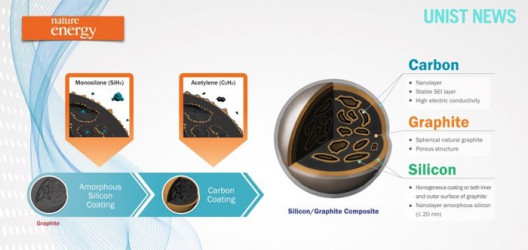A Long-term Collaboration
Dr. Jaephil Cho is a well-known battery researcher and inter-continental associate of Dr. Yi Cui of Stanford University. The pair has collaborated on many ways to improve battery performance and longevity, and both have appeared at various electric aircraft symposia. They have even inspired others in related research. Dr. Cho and his team at Ulsan National Institute of Science and Technology (UNIST) in South Korea announced a way to make a new generation battery anode material – a big move toward mass production of improved cells.
Dr. Cho’s team of researchers affiliated with Ulsan National Institute of Science and Technology (UNIST), South Korea, claims to have made yet another step towards finding a solution to accelerate the commercialization of silicon anodes for Lithium-ion batteries.
A Next-generation Hybrid Anode
As reported by UNIST, “Prof. Cho and his research team have developed a new type anode material that would be used in place of a conventional graphite anode, which they claim will lead to lighter and longer-lasting batteries for everything from personal devices to electric vehicles.”

Instead of a pomegranate like Dr. Cui’s battery materials, Dr. Cho’s looks more like a malted milk ball (at least to your editor)
A next-generation hybrid anode using silicon-nanolayer-embedded graphite/carbon suffered many of the problems associated with the use of silicon as an active material in batteries. The material is great at soaking in lithium during charging, and releasing it during discharge. This repeated expansion and contraction of the silicon causes it to crumble over time, diminishing and finally destroying the battery’s performance. Such structural failures occur with silicon particles made by conventional mechanical milling.
Drs. Cui and Cho have developed various approaches that ended up looking like fruits or other organic materials, copying nature in their structure. Interestingly, this structure looks more like a malted milk ball to your editor.
660 Pounds in Six Hours
A newly-developed anode material has been manufactured with an increase in graphite content in composite by 45 percent. The research team even developed new equipment capable of producing 300 kilograms (660 pounds) in six hours per batch using a small amount of silane gas (SiH4), a simple procedure expected to ensure a competitive price. Industrial-size outputs at this stage of development seem to show a clear path to commercialization.
According to UNIST, “They report that the silicon/graphite composite is mass-producible and it has superior battery performances with industrial electrode density, high areal capacity, and low amounts of binder.”
This work has been supported by the IT R&D program of the Ministry of Trade, Industry & Energy (MOTIE) and Korea Evaluation Institute of Industrial Technology (KEIT), 2016 Research Fund of UNIST, and by the Office of Vehicle Technologies, Battery Materials Research Program of the US Department of Energy.
Minseong Ko, Sujong Chae, Jiyoung Ma, Namhyung Kim, Hyun-Wook Lee, Yi Cui, and Jaephil Cho published “Scalable synthesis of silicon-nanolayer-embedded graphite for high-energy lithium-ion batteries,” in the August, 2016 issue of Nature Energy.
